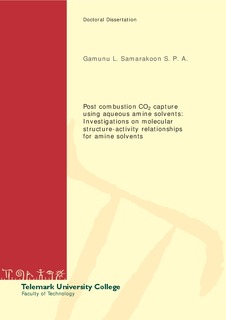Post combustion CO2 capture using aqueous amine solvents: Investigations on molecular structure-activity relationships for amine solvents
Doctoral thesis, Peer reviewed
Published version
Permanent lenke
http://hdl.handle.net/11250/2437781Utgivelsesdato
2015-06-25Metadata
Vis full innførselSamlinger
Originalversjon
Arachchige, G.L.S. Post combustion CO2 capture using aqueous amine solvents: Investigations on molecular structure-activity relationships for amine solvents. Porsgrunn: Telemark University College, 2015Sammendrag
The study in this dissertation focuses on chemical absorption of CO2 using aqueous amine which is expected to be the technology of choice for early large scale deployment of postcombustion carbon capture (PCC). However the technology still faces challenges. Reduction in cost of this process, in terms of both capital and operational is required to make the process economically feasible. One possible approach for it, is the improvement of absorbents. Since this process is chemically driven, understanding fundamental chemistry of amine-CO2 reactivity could assist the rational development of the absorbents. With respect to primary and secondary amines, the amine carbamate formation reaction and the carbamate hydrolyses reaction are important reactions. The equilibrium constants governing these reactions can define the performance of amine solvents. Understanding the molecular structure-activity relationships for the CO2-aqueous amine reactions aid prediction/estimation of their equilibrium constants. The influence of molecular structure on the free energy of activation of a reaction or the reaction may be treated as the sum of independent contributions of polar, resonance and steric effects of substituents in the molecule. We can separate theses effects individually and assign numerical values to elements or substituent groups as empirical constants related to their effects on reaction rates and equilibria. The “Taft polar parameter” defines a quantitative scale which assigns a value to the polar nature of a substituent. The study reported in this thesis aims to increase understanding of aqueous amine-CO2 reactivity and estimate the equilibrium constants of carbamate formation and carbamate hydrolysis reactions by means of Taft polar parameter. According to the relations between Taft polar parameter and the equilibrium constants, relative reduced electron density on N atom leads to increased alkylamine carbamate formation and decreased alkylamine carbamate hydrolysis. Note that this study is limited to primary (1o) alkylamines. The relative electron density, present on the N nucleus, which is depending on molecular structure and medium effects influences the chemical reactions between amine and CO2. Therefore, 15N NMR experiment data was also used to qualitatively analyse the structure-activity relationships of 1o alkylamines. The current study provides evidence that in addition to polar effects from substituents, water solvents and steric hindrance (in terms of electron delocalization) influence the reaction of the alkylamine toward CO2. The results show that higher basicity and higher α -C substituent effect (steric hindrance) reduce carbamate formation. Further, this dissertation includes modifying analytical methods for speciation in carbonated aqueous amine solutions which is required to determine the equilibrium constants of interested reactions. In this respect, a complementary wet chemical method (WCM) for determination of species distribution in carbonated aqueous amine solution was developed. The method employs analytical techniques readily available in any laboratory. The results obtained using WCM were compared to those obtained using 13C NMR analysis for identical solutions for validation. They were in good agreement. The method was then used for speciation in carbonated primary alkylamine solutions; propyl-, butyl- and pentylamine. Application of Raman spectroscopy as an analytical tool to determine the speciation of carbonated aqueous alkanolamine systems was attempted. It constitutes a simple ‘short-cut’ type approach to semi-quantitative speciation information employing measurement of selected Raman bands in conjunction with an internal standard (ClO4 −), assisted by 13C-NMR .
Består av
Paper I: Arachchige, G. L. S., Andersen, N. H., Perinu, C., & Jens, K.-J. (2013). Equilibria of MEA, DEA and AMP with Bicarbonate and Carbamate: a Raman Study. Energy Procedia, 37, 2002-2010. http://dx.doi.org10.1016/j.egypro.2013.06.080.Paper II: Perinu, C., Arachchige, G. L. S., Arstad, B. & Jens, K.-J. (2014). Application of 15N-NMR spectroscopy to analysis of amine based CO2 capture solvents. Energy Procedia, 63, 1144-1150. http://dx.doi.org/10.1016/j.egypro.2014.11.124
Paper III: Arachchige, G. L. S., Svendsen, J.A., Perinu, C., & Jens, K.-J. Speciation of carbonated aqueous amine solutions for CO2 capture. Submitted for publication. Full text not available.
Paper IV: Arachchige, G. L. S., Perinu, C., & Jens, K.-J. Correlations of carbamate related equilibrium constants: structure-reactivity relationships. In preparation (manuscript is not attached in this dissertation).
